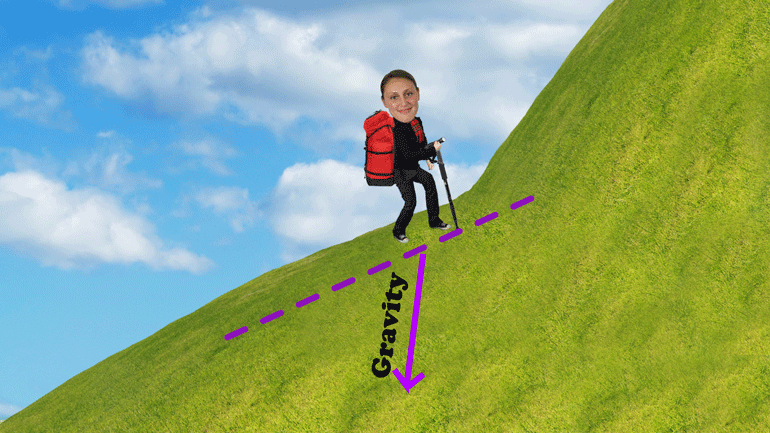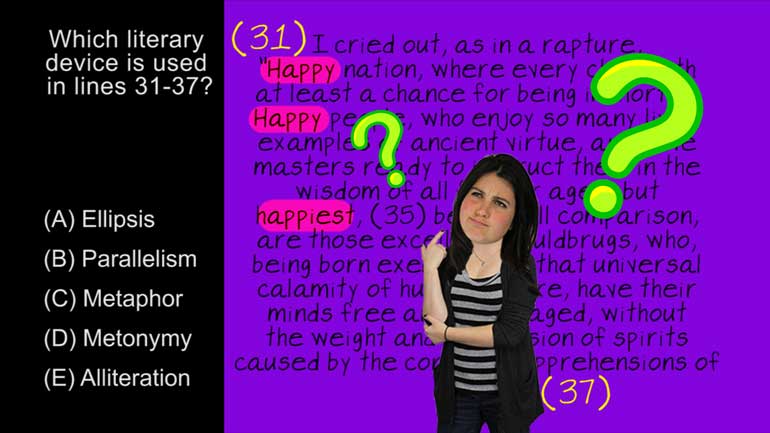ShmoopTube
Where Monty Python meets your 10th grade teacher.
Search Thousands of Shmoop Videos
Physics Videos 34 videos
Isaac Newton. Who was he? Why do we need to know about him? In a physics course, no less? Well, he's only the most famous physicist in history, and...
What are the basics of trigonometry? And why are we learning about this in a physics course? Both good questions. In this video, you'll learn about...
It's time to make our liters and meters work together. Enough of the bickering, right? In this video, we'll do some unit analysis, covering SI Unit...
Physics: The Basics of Trigonometry 35 Views
Share It!
Description:
What are the basics of trigonometry? And why are we learning about this in a physics course? Both good questions. In this video, you'll learn about sines, cosines, tangents, and more... and about how these concepts are applied to physics. Sorry - math and physics go hand-in-hand. Let's just hope they regularly use Purell.
Transcript
- 00:02
Basics of trigonometry.....[mumbling]
- 00:46
In this lesson we're gonna be talking about triangles aren't specifically right [Triangle teaching a class of students]
- 00:50
triangles and as we're sure you know right triangle is a triangle with a
- 00:54
right angle also known as a ninety degree angle and wait are you confused?
- 00:58
wondering if you clicked on a geometry video by mistake well no this is
Full Transcript
- 01:03
definitely physics and physics uses a lot of trigonometry sine cosine tangent [Trigonometry record playing]
- 01:08
you know all the classics just in case you haven't played around with trig
- 01:12
before it's the study of right triangles now you may think well what's there to
- 01:17
study three sides 90 degree angle boom got it but believe it or not
- 01:21
mathematicians managed to make it a bit more complicated and why is this
- 01:26
important to physics well to answer that let's take a drive say we need to get
- 01:30
from home to the store and the good news is it's a straight shot just a quick two [Home and store on a google map]
- 01:35
kilometer drive away and hey we're physicists that's the value of length
- 01:39
kilometers well we've done plenty of work with that kind of thing so we're
- 01:43
just rolling along here and just knowing we have to drive two kilometers isn't [Right triangle driving a car]
- 01:47
going to get us to the store you also have to know what direction to go right
- 01:51
otherwise we might just end up in the middle of nowhere so we need to know
- 01:55
how long the drive is and which way we're going like if the store we're
- 02:00
driving to is two kilometers to the east that's the difference between scalar and
- 02:05
vector quantities well a scalar quantity is it's something
- 02:10
that just has a value you might see that referred to as a magnitude but when we
- 02:16
said we needed to drive two kilometers that was a scalar value a vector
- 02:21
quantity has both a value aka a magnitude and a direction all right so
- 02:27
two kilometers to the east is a vector quantity now we're gonna come back to [Bucket of scalars appear]
- 02:31
scalars and vectors later in the course but it's important we know the basics
- 02:34
here why why is that important well it's pretty obvious that vectors give us more
- 02:39
information and we like information and all vectors can be broken down into
- 02:43
perpendicular horizontal and vertical components using......... trigonometry
- 02:49
yes! all right so let's say the magic word to open up the wonderful [Magician waving wand]
- 02:53
world of trig sohcahtoa not quite the classic like Shazam
- 02:58
but sohcahtoa is a little more useful in the real world before we explain what
- 03:03
that word means well let's take a close look at a right triangle again the
- 03:07
defining characteristic of a right triangle is that 90-degree angle the [90 degree angle in triangle appears]
- 03:11
side of our triangle opposite the right angle is the hypotenuse it's the longest
- 03:16
side of the shape so obviously we've got two other angles and two other sides
- 03:21
well the two other angles are called the complementary angles and what are those [Complimentary angles highlighted]
- 03:26
sides called well they're called the adjacent and the opposite sides but
- 03:31
which is which different which well it depends on which angle were working with
- 03:36
so let's just pick one of the complementary angles and we'll go with
- 03:40
this one well the side of the triangle that's next to the angle and not the
- 03:44
hypotenuse is our adjacent side and the side that's opposite this angle is
- 03:49
well the opposite side makes sense right if we look at the other angle instead [Opposite angle highlighted]
- 03:53
the adjacent and opposite sides change oh and now whichever angle we're looking
- 03:58
at gets this theta symbol it's just a way to show which angle we're dealing
- 04:02
with there are mathematical functions that are a part of trig yeah these
- 04:06
functions relate the angles of a triangle to the lengths of its sides and
- 04:10
you might be asking yourself huh yeah so let's take a second and break a triangle [Man scratching head and stopwatch appears]
- 04:16
down all right what makes a triangle a
- 04:19
triangle those three angles right that's why it's tri angle and if we measure
- 04:23
those angles with the protractors we all keep under our pillows well we find that
- 04:28
when we add up all those angles the sum is 180 degrees and that goes for every
- 04:33
triangle the three interior angles always add up to 180 degrees so in a [Selection of triangles appear]
- 04:38
right triangle we already know that one angle is precisely ninety degrees which
- 04:41
means that the other ninety degrees that are left over will be split up between
- 04:45
the complementary angles so if angle B here is thirty degrees it's buddy angle
- 04:49
C here will be 60 degrees and this is the basis of trig functions in fact
- 04:54
let's investigate one of these functions and we'll start with the sine function
- 04:58
well the sine of an angle is the ratio of the angles opposite side and the [Sine function of angle appears]
- 05:03
hypotenuse and since we're dealing with a ratio it doesn't matter if the
- 05:06
triangle is ginormous or if it's tiny if the angle is the same then the ratio
- 05:12
between the opposite and adjacent sides will be the same another one of
- 05:16
trigonometry's' greatest-hits is the cosine
- 05:20
all right the cosine is the ratio of an angles adjacent side to the hypotenuse [Cosine equation appears]
- 05:24
and last but not least is the tangent that's the ratio of the angles opposite
- 05:29
to its adjacent side okay one more time sine is opposite over hypotenuse cosine
- 05:34
is adjacent over hypotenuse tangent is opposite over adjacent how do we
- 05:41
remember this sohcahtoa and you thought we were just saying gibberish all right
- 05:46
well trigonometry started with this ancient Greek dude named Pythagoras and [Pythagoras with Greek friends appear]
- 05:50
the ancient Greeks took their math pretty seriously and cult even crew
- 05:54
around Pythagoras not a cult as in he was cool and underground and then he hit
- 05:59
it big and everyone called him a sellout a cult as in an actual religious cult
- 06:03
some ancient texts even claimed that if cult members told outsiders about some [Cult member whispering to outsider]
- 06:08
of the math they did well, that member would and should be killed that were a
- 06:12
bit more children then.. also a lot of this stuff was known in China and
- 06:16
Babylon thousands of years before Pythagoras but whatever
- 06:19
Pythagoras name lives on in the Pythagorean theorem might be the most
- 06:22
famous mathematical formula ever or at least close second to that e equals [Pythagoras and Einstein on stage together]
- 06:27
mc-squared the Pythagorean theorem says that the
- 06:30
some of the squares of the two shorter sides of a right triangle, lets call
- 06:35
those A and B equals the square of the hypotenuse which we'll call C so A
- 06:39
squared plus B squared equals C squared and knowing this formula means that if
- 06:44
we know any two sides of a right triangle we can solve for the other side
- 06:48
so if we know A and B we know that C equals the square root of a squared plus [C side of triangle square root of A and B side appears]
- 06:52
B squared Pythagoras you clever dog you thanks for
- 06:56
the help okay so, so far we've been talking a lot of math why don't we just
- 07:00
see all this math in action...Let's say we live out in the country somewhere and
- 07:05
we want to see if Granny Shmoop sent us some birthday cash or our mailbox is five [Woman walks out onto front porch]
- 07:09
hundred meters to the east and five hundred meters to the north we want to
- 07:12
make life a little easier and take the shortest route possible well let's start
- 07:16
by drawing out what we have so far aha it's like we've got ourselves a right
- 07:21
angle it also looks like two sides of a triangle and the shortest path to get
- 07:25
that birthday card from Grandma? Yeah, it's gonna be the hypotenuse of this triangle
- 07:29
right here so our old pal Pythagoras told us that A squared plus B squared
- 07:33
equals C squared and we've got an A and a B here they're both 500 so the [Pythagoras theorem and right triangle appears]
- 07:38
hypotenuse will equal the square root of the sum of 500 meters squared plus 500
- 07:43
meters squared go ahead grab a calculator you don't have one already [Person using a calculator]
- 07:45
and our calculator tells us that the answer is 707 point whatever a whole
- 07:51
buncha numbers that we don't really need to worry about because we only need two
- 07:53
around the closest meter so our little shortcut will be a 707 meters long and
- 07:58
we're dealing with a vector quantity here so we need to factor in that
- 08:02
direction 707 meters northeast and hopefully Grandma come through with a fat [Girl opens mail box and stacks of cash appear]
- 08:07
stack of cash but hold on a second just for funsies let's figure out the angle
- 08:13
we'll be creating by taking this path yes this is what we consider funsies now
- 08:18
we'll be honest we could totally cheat here if you have a right triangle where
- 08:21
the opposite and adjacent sides are the exact same length while the two
- 08:25
complementary angles are gonna be 45 degrees each but if we just spit out
- 08:30
that answer we'd never get to learn about the inverse trig functions yeah [Boy studying at his desk]
- 08:34
there are more than just three trig functions sine cosine and tangent each
- 08:38
have corresponding inverse functions those would be the arcsine, arccosine
- 08:42
and arctangent functions you might also see them written like the
- 08:47
original big three but with a negative one added in the superscript not that
- 08:52
the inverse functions are actually the negative first power it's really just a [Right sided triangle talking under spotlight]
- 08:56
notation convention and what do we mean when we say inverse well if sine(x)
- 09:01
equals y then arcsine y equals x or to put it another way if we know the
- 09:08
degrees in an angle we can use the sine function to find a value for the ratio
- 09:12
between the opposite side and the hypotenuse if we have a right triangle
- 09:17
with a complementary angle of 30 degrees the sine of that angle will be 0.5 also [30 degree angle of triangle appears]
- 09:24
known as 1 over 2 and since sine equals opposite over hypotenuse well that means
- 09:30
that the hypotenuse will be twice as long as the angles opposite side but
- 09:35
what if we don't know the value of that angle well if we know how long the
- 09:38
hypotenuse is and the opposite side is 30 meters for the big H here and 15 for
- 09:45
its little pal oh well we can do that division and find a ratio of 1 over 2
- 09:50
also known as 1/2 yeah we can pop that number into the arcsine function to see
- 09:54
how many degrees are in this angle and what do you know while the arcsine
- 09:58
function tells us the angle is 30 degrees so sine uses the degrees in an [30 degree angle highlighted]
- 10:03
angle to find how the opposite side and hypotenuse are related while its inverse
- 10:08
function arcsine uses the ratio of the opposite side and the hypotenuse to find
- 10:14
how many degrees are in the angle so let's find the value of this angle by
- 10:18
starting with its tangent sohcahtoa reminds us that the tangent is the
- 10:22
opposite over the adjacent and in this case both are 500 meters meaning our
- 10:27
tangent is 1 we can get the value for the angle by applying the inverse [Tangent angle formula appears]
- 10:31
function to each side of the equation now on the left hand side the inverse
- 10:37
tangent and tangent will cancel each other out
- 10:39
making the value of the angle equal to the arctangent of 1 plug that into your
- 10:44
calculator making sure you're using the inverse tangent and that it's set for [Boy using calculator]
- 10:48
degrees and we'll find out the value of the angle is yeah drumroll.......
- 10:52
45-degrees kind of anticlimactic since we already said that's what it would be
- 10:56
but still starting to see how all these triangles are gonna help us influence [Right triangles helping to lift mans boxes]
- 11:00
well that wasn't super heavy on the physics side so look at one more problem
- 11:04
remember our pendulum experiment well it's back baby we're not gonna just
- 11:09
forget about our little pendulum buddy so let's say we've got a pendulum that's [Man puts pendulum on door frame]
- 11:13
half a meter long and we want to know what the height of the weight would be
- 11:17
if we pull the pendulum to a 30-degree angle well because when we pull the
- 11:21
weight to this side it'll be higher up right here's a diagram it looks pretty
- 11:25
triangular doesn't it we've got L for the total length of the string and H for the
- 11:30
difference in height and we want to figure out what the difference in
- 11:32
height will be well let's label each part of this diagram obviously the
- 11:36
length of the string doesn't change so that makes our hypotenuse L which means [hypotenuse labelled L on triangle]
- 11:40
that the vertical part of this triangle equals L minus H and that 30-degree
- 11:45
angle will be our theta so for our angle the vertical side will be the adjacent
- 11:50
side and we know the length of the hypotenuse and yeah, sohcahtoa we've got
- 11:54
ourselves a cosine situation so here's the equation the cosine of theta equals
- 12:00
L minus H the adjacent side over L the hypotenuse now we just have to solve for
- 12:06
H we'll get everything on the same level by multiplying each side by L giving us
- 12:11
L times cosine of theta equals L minus H now we can isolate H the easiest way to
- 12:17
do that is to add H to both sides and then subtract L times cosine theta from
- 12:21
each side and that leaves us with this equation H equals L meters minus the
- 12:26
product of L times the cosine of theta now I can just plug in our numbers H
- 12:31
equals 0.5 meters minus the product of 0.5 meters times the cosine of 30 [Formula appears]
- 12:34
degrees when we use our calculator to find the cosine of 30 degrees there
- 12:38
we've only got one sig fig to deal with here so well that becomes 0.07 meters
- 12:43
also known as seven centimeters now that's bringing trig into the physical
- 12:48
world so there you go some old guy with a weird name did all this math few [Right triangle discussing trigonometry and Pythagoras appears]
- 12:52
thousand years ago and here we are doing it on some piece of technology that
- 12:55
would blow his ancient Greek mind that's right Pythagoras you might have taught
- 12:59
us that the shortest distance between two points is a straight line but we
- 13:03
know better the shortest distance between two points is
- 13:06
whatever our GPS tells us to do [Right triangle hands smart phone to Pythagoras]
Related Videos
When you're about to marry the love of your life, not many things could stop you. However, finding out that your future hubby is keeping his crazy...
Here at Shmoop, we work for kids, not just the bottom line. Founded by David Siminoff and his wife Ellen Siminoff, Shmoop was originally conceived...
ACT Math: Elementary Algebra Drill 4, Problem 5. What is the solution to the problem shown?
AP® English Literature and Composition Passage Drill 1, Problem 1. Which literary device is used in lines 31 to 37?
AP® English Literature and Composition Passage Drill 2, Problem 1. What claim does Bacon make that contradicts the maxim "Whatsoever is delig...






































